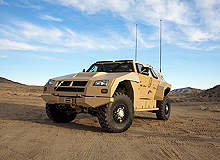
According to Emerson Network Power, which has been designing and developing power supply products for the military and aerospace markets for over 35 years, the global military electronics market is worth about $77bn a year, while the global military avionics market is worth about $13.5bn a year, adding that the use of commercial-off-the-shelf (COTS) equipment and systems in military applications continues to increase.
Emerson says that many of the AC-DC power supplies and DC-DC converters that are produced for military and aerospace applications are customised products, which need to be especially rugged and to have unique characteristics. It adds that the key attribute of power supplies for military and aerospace applications is usually reliability – especially in environments involving extended operating temperature ranges and/or extreme shock and vibration.
GE Aviation, one of the world’s leading suppliers of power systems for military aircraft, expects that the next generation of military aircraft will demand the most exacting power systems ever developed. It says it is “leading the way toward advanced power integration” with products such as the user-configurable modular power tile (MPT), which offers flexible power “from a scalable, off-the-shelf design”. The MPT is already in use on the US military’s JSF programme. A software-driven power distribution system, the power tile allows for duty cycle reprogramming over time as aircraft electrical demands change.
Pressure on military budgets means that defence officials are focusing on upgrading avionics systems in aircraft rather than expecting to order new platforms. This is the case with the US Army, which is seeking new avionics systems that will keep its existing helicopter fleet flying well into the next decade. The new avionics systems will incorporate COTS components to keep costs down and enable rapid deployment. This follows the cancellation of the armed reconnaissance helicopter and the RAH-66 Comanche programmes in the last decade.
The fibre-optic future
However, the US continues to invest heavily in avionics research and in January 2011 the Defense Advanced Research Projects Agency (DARPA), the research and development office for the US Department of Defense, said that its “network enabled by wavelength division” was working on a highly integrated photonics (NEW-HIP) programme, which aims to replace aircraft wiring with a single-mode fibre-optic network, where each fibre can carry multiple digital and analogue signals. The programme is being researched and developed by APIC, a Los Angeles-based pioneer of photonics technology integrated monolithically with electronics.
According to DARPA, military aircraft contain miles of heavily shielded copper wire cables that connect a multitude of components. The cabling is heavy and subject to harsh conditions that cause it to deteriorate. The cables required for analogue radio frequency signals are also expensive, fragile and difficult to install and replace, while some more modern aircraft employ multimode fibre cables, which can carry only a single digital signal. A single-mode fibre-optic network, where each fibre can carry multiple digital and analogue signals, should lead to large weight savings, leading to greater fuel efficiency and a potential reduction in installation and maintenance costs.
How well do you really know your competitors?
Access the most comprehensive Company Profiles on the market, powered by GlobalData. Save hours of research. Gain competitive edge.

Thank you!
Your download email will arrive shortly
Not ready to buy yet? Download a free sample
We are confident about the unique quality of our Company Profiles. However, we want you to make the most beneficial decision for your business, so we offer a free sample that you can download by submitting the below form
By GlobalDataDemand for electrical power on military vehicles has never been greater and is predicted to continue rising, according to Rolls-Royce. Fuel efficiency is an increasing concern, and Rolls-Royce says its systems are designed to operate on diesel and JP8 fuels. Options include cyclonic air filtration, remote operation and variable speed systems for optimum fuel efficiency.
Rolls-Royce also supplies electric drive systems to military vehicles and says it enables a holistic approach to power generation and management for the vehicle and its electronic architecture. Hybrid-electric systems provide energy storage to deliver power for onboard systems and to support the engine at peak times.
According to Rolls-Royce, replacing a conventional, rigid drive shaft with flexible cables allows a modular and innovative approach to vehicle design.<?p>
In terms of operational capability and performance, hybrid electric drive systems can increase mobility and acceleration, provide fuel efficiencies, reduce signatures for stealth requirements, and enable “silent watch” capability, the company says. Rolls-Royce also supplies mobile and portable power systems to the military, with features including stealth-type technology, which reduces radar, acoustic and thermal signatures; user-friendly health and usage monitoring; control systems providing prognostics and diagnostics; and maintenance and repair schedules.
The $300,000 military vehicle
The next generation of military vehicles will be more sophisticated and costly than today’s vehicles, according to a recent US Army report. It said this stemmed from the dangerous roads of Iraq and Afghanistan, which have forced changes in what soldiers drive. The joint light tactical vehicle (JLTV) will cost in excess of $300,000 before equipping with essential combat systems. By comparison, the military workhorse, the Humvee, carried a $70,000 price tag, rising to $220,000 as extra armour and systems were added.
“To meet the threat on today’s battlefields, trucks must now be armoured, have the additional capacity and power to carry that armour, and be outfitted with a wide variety of command, control, communications and computers, and intelligence, surveillance and reconnaissance equipment,” the report says.
The JLTV generates enough exportable power to run a field hospital, while its power plant was designed to supply power for on-board electronic components with the engine on and during extended silent watch. The JLTV is required to generate 30kW of exportable power, to include 10kW of on-board 28V DC power.




